MERCEDES-BENZ CLS-Class 2014 W218 Owner's Manual
Manufacturer: MERCEDES-BENZ, Model Year: 2014, Model line: CLS-Class, Model: MERCEDES-BENZ CLS-Class 2014 W218Pages: 382, PDF Size: 5.36 MB
Page 331 of 382

It is better to have the vehicle transported
than to have it towed.
If the vehicle has suffered transmission
damage, have it transported on
atransporter
or trailer.
The automatic transmission must be in
position Nwhen the vehicle is being towed.
The battery must be connected and charged.
Otherwise ,you:
R cannot turn the SmartKey to position 2in
the ignition lock
R cannot shift the automatic transmission to
position N
i Deactivate the automatic locking feature
(Y page 83). You could otherwis ebelocked
out when pushing or towing the vehicle. Installing/removing the towing eye
Installing the towing eye G
WARNING
The exhaust tail pipe may be very hot. There
is ar isk of burns when removing the rear
cover.
Do not touch the exhaust pipe.T ake particular
car ew hen removin gthe rear cover. Example
:towing eye covers Towing eye covers (AMG vehicles)
The mountings for the removable towing eyes
are located in the bumpers. They are at the
front and at the rear, behind the covers.
X Remove the towing eye from the vehicle
tool kit (Y page 320).
X Pull cover 001Aout of the bumper in the
direction of the arrow by inserting your
fingers into the recess.
X Press the mark on cover 0010inwards in the
direction of the arrow. Towing and tow-starting
329Breakdown assistance Z
Page 332 of 382
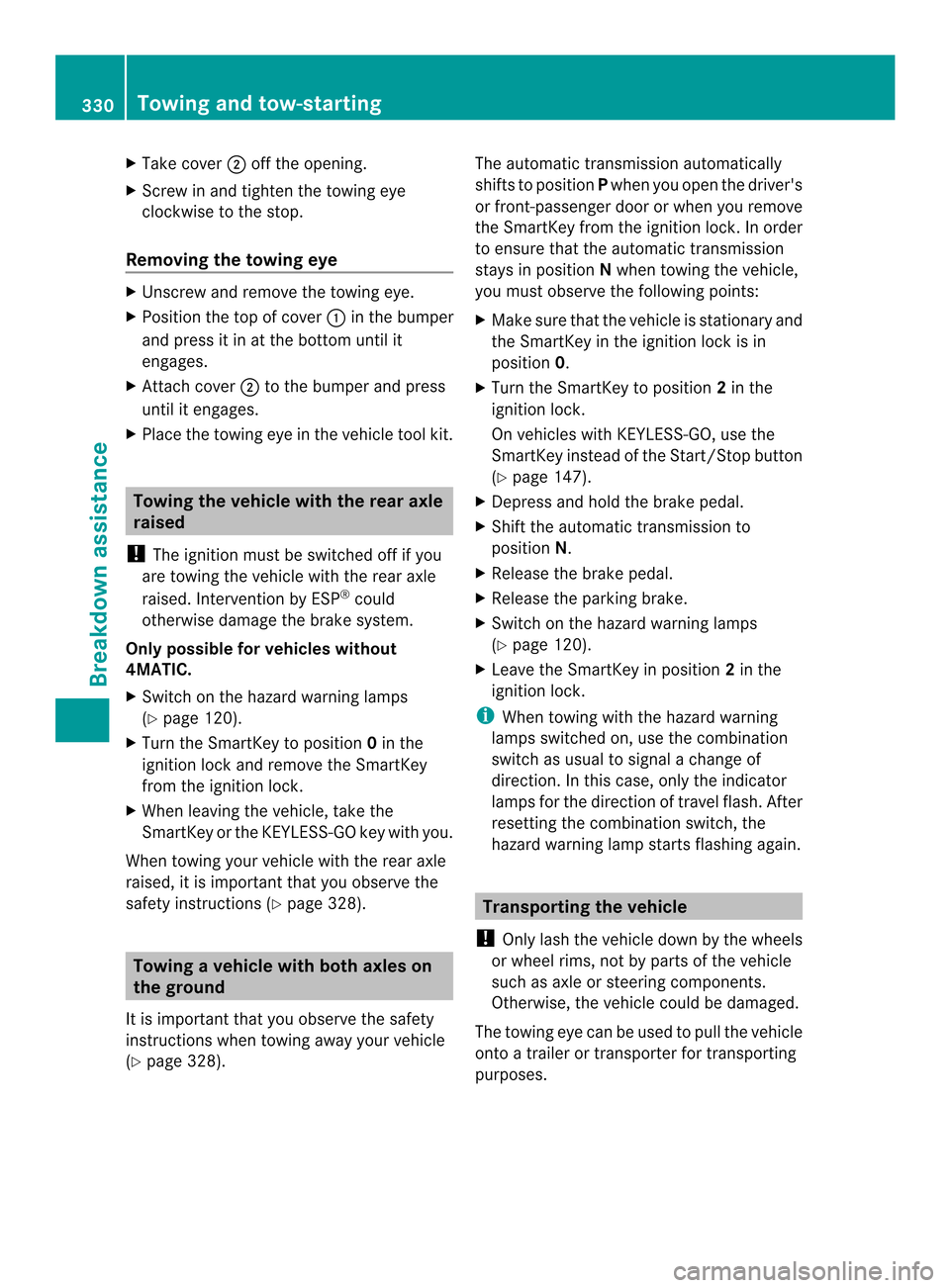
X
Take cover 0010off the opening.
X Screw in and tighten the towing eye
clockwise to the stop.
Removing the towing eye X
Unscrew and remove the towing eye.
X Position the top of cover 001Ain the bumper
and press it in at the bottom until it
engages.
X Attach cover 0010to the bumper and press
until it engages.
X Place the towing eye in the vehicle tool kit. Towing the vehicle with the rear axle
raised
! The ignition must be switched off if you
are towing the vehicle with the rear axle
raised. Intervention by ESP ®
could
otherwise damage the brake system.
Only possible for vehicles without
4MATIC.
X Switc hont he hazard warning lamps
(Y page 120).
X Turn the SmartKey to position 0in the
ignition lock and remove the SmartKey
from the ignition lock.
X When leaving the vehicle, take the
SmartKey or the KEYLESS-GO key with you.
When towing your vehicle with the rear axle
raised, it is importan tthat you observe the
safety instructions (Y page 328).Towing
avehicle with both axles on
th eg round
It is importan tthat you observe the safety
instructions when towing away your vehicle
(Y page 328). The automatic transmission automatically
shifts to position
Pwhen you open the driver's
or front-passenger door or when you remove
the SmartKey from the ignition lock. In order
to ensure that the automatic transmission
stays in position Nwhen towing the vehicle,
you must observe the following points:
X Make sure that the vehicle is stationary and
the SmartKey in the ignition lock is in
position 0.
X Turn the SmartKey to position 2in the
ignition lock.
On vehicles with KEYLESS-GO, use the
SmartKey instead of the Start/Stop button
(Y page 147).
X Depress and hold the brake pedal.
X Shift the automatic transmission to
position N.
X Release the brake pedal.
X Release the parking brake.
X Switch on the hazard warning lamps
(Y page 120).
X Leave the SmartKey in position 2in the
ignition lock.
i When towing with the hazard warning
lamps switched on, use the combination
switch as usualtos ignalachange of
direction. In this case, only the indicator
lamps for the direction of travel flash. After
resetting the combination switch, the
hazard warning lamp starts flashing again. Transporting the vehicle
! Only lash the vehicle down by the wheels
or wheel rims, not by parts of the vehicle
such as axle or steering components.
Otherwise, the vehicle could be damaged.
The towing eye can be used to pull the vehicle
onto atrailer or transporter for transporting
purposes. 330
Towing and tow-startingBreakdown assistance
Page 333 of 382
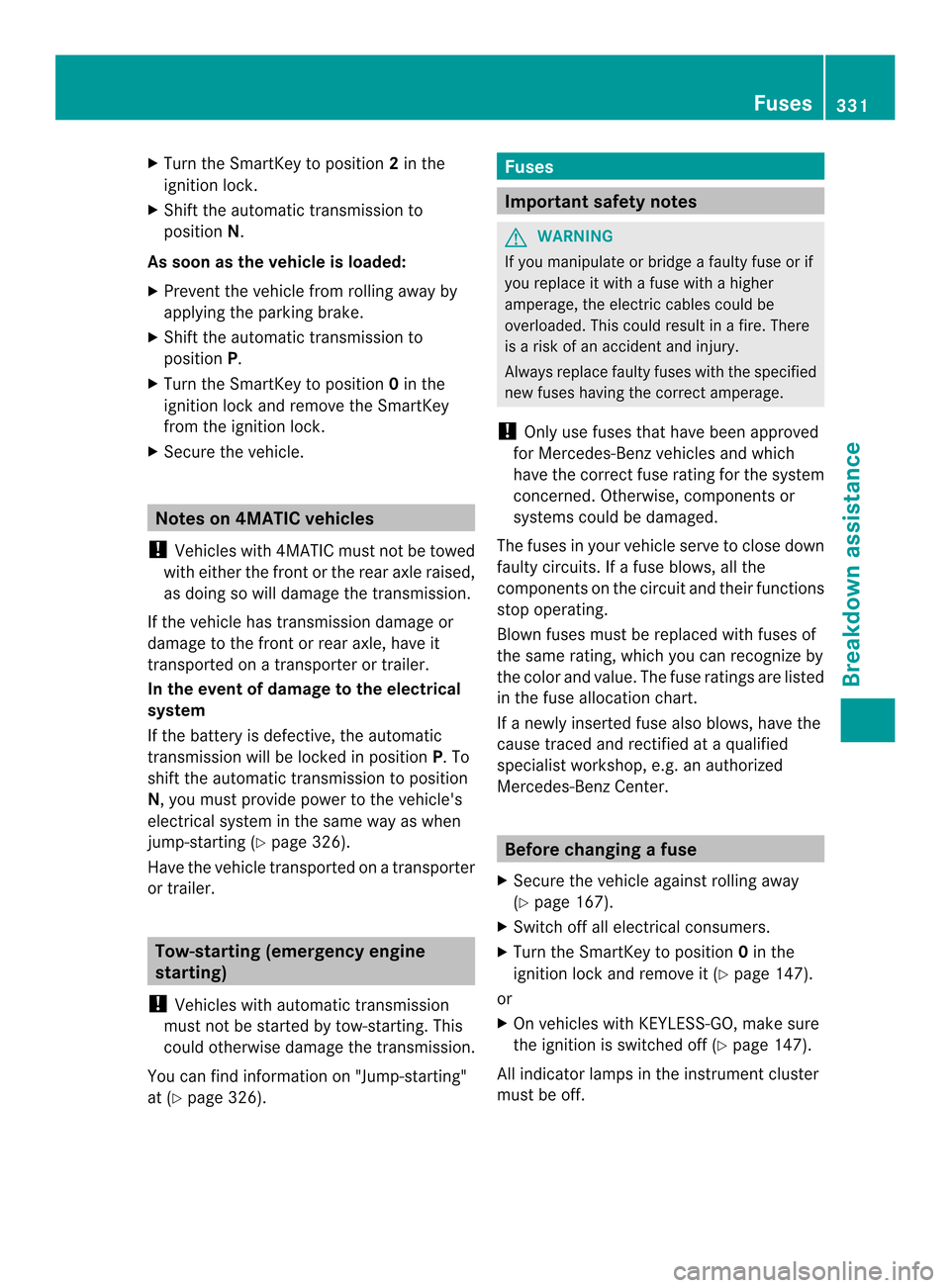
X
Turn the SmartKey to position 2in the
ignition lock.
X Shift the automatic transmission to
position N.
As soon as the vehicle is loaded:
X Prevent the vehicle from rolling away by
applying the parking brake.
X Shift the automatic transmission to
position P.
X Turn the SmartKey to position 0in the
ignition lock and remove the SmartKey
from the ignition lock.
X Secure the vehicle. Notes on 4MATIC vehicles
! Vehicles with 4MATI Cmust not be towed
with either the frontort he rear axle raised,
as doing so will damage the transmission.
If the vehicle has transmission damage or
damage to the front or rear axle, have it
transported on atransporter or trailer.
In the event of damage to the electrical
system
If the battery is defective, the automatic
transmission will be locked in position P.To
shift the automatic transmission to position
N,y ou must provide power to the vehicle's
electrical system in the same way as when
jump-starting (Y page 326).
Have the vehicle transported on atransporter
or trailer. Tow-starting (emergency engine
starting)
! Vehicles with automatic transmission
must not be started by tow-starting. This
could otherwise damage the transmission.
You can find information on "Jump-starting"
at (Y page 326). Fuses
Important safety notes
G
WARNING
If you manipulate or bridge afaulty fuse or if
you replace it with afuse with ahigher
amperage, the electric cables could be
overloaded. This could result in afire. There
is ar isk of an accident and injury.
Always replace faulty fuses with the specified
new fuses having the correct amperage.
! Only use fuses that have been approved
for Mercedes-Ben zvehicles and which
have the correct fuse ratin gfor the system
concerned. Otherwise, componentsor
systems could be damaged.
The fuses in your vehicle serve to close down
faulty circuits. If afuse blows ,all the
component sonthecircuit and their functions
stop operating.
Blown fuse smust be replace dwith fuses of
the same rating, which you can recognize by
the color and value. The fuse ratings are listed
in the fuse allocation chart.
If an ewly inserted fuse also blows, have the
cause traced and rectified at aqualified
specialist workshop, e.g. an authorized
Mercedes-Ben zCenter. Befor
echanging afuse
X Secure the vehicle against rolling away
(Y page 167).
X Switc hoff all electrical consumers.
X Turn the SmartKey to position 0in the
ignition lock and remove it (Y page 147).
or
X On vehicles with KEYLESS-GO, make sure
the ignition is switched off (Y page 147).
All indicator lamps in the instrument cluster
must be off. Fuses
331Breakdown assistance Z
Page 334 of 382

The fuses are located in various fuse boxes:
R Fuse box in the engine compartment on the
left-hand side of the vehicle, when viewed
in the direction of travel
R fuse box in the trunk on the right-hand side,
when viewed in the direction of travel
the fuse allocation chart is located in the
vehicle tool kit in the stowage compartment
under the trunk floor (Y page 320).Fuse box in the engine compartment
G
WARNING
When the hood is open and the windshield
wipers are set in motion ,you can be injured
by the wiper linkage. There is arisk of injury.
Always switch off the windshield wipers and
the ignition before opening the hood.
! Make sure that no moisture can enter the
fuse box when the cover is open.
! When closing the cover, make sure that it
is lying correctly on the fuse box. Moisture
seeping in or dirt could otherwise impair
the operation of the fuses.
X Make sure that the windshield wipers are
turned off.
X Open the hood. X
Use adry cloth to remove any moisture
from the fuse box.
X To open: remove lines 0010from the guides.
X Move lines 0010aside. Route the lines behind
connection 0024to do this. X
Open clamp 001A.
X Remove the fuse box cover forwards.
X To close: check whether the rubber seal is
lying correctly in the cover.
X Insert the cover at the rear of the fuse box
into the retainer.
X Fold down cover and close clamps 001A.
X Secure lines 0010in the guides.
X Close the hood. Fuse box in the trunk
! Make sure that no moisture can enter the
fuse box when the cover is open.
! When closing the cover, make sure that it
is lying correctly on the fuse box. Moisture
seeping in or dirt could otherwise impair
the operation of the fuses.
X Open the trunk lid. X
To open: release cover 001Aat the top right
and left-hand sides with aflat object.
X Open cover 001Adownwards in the direction
of the arrow. 332
FusesBreakdown assistance
Page 335 of 382
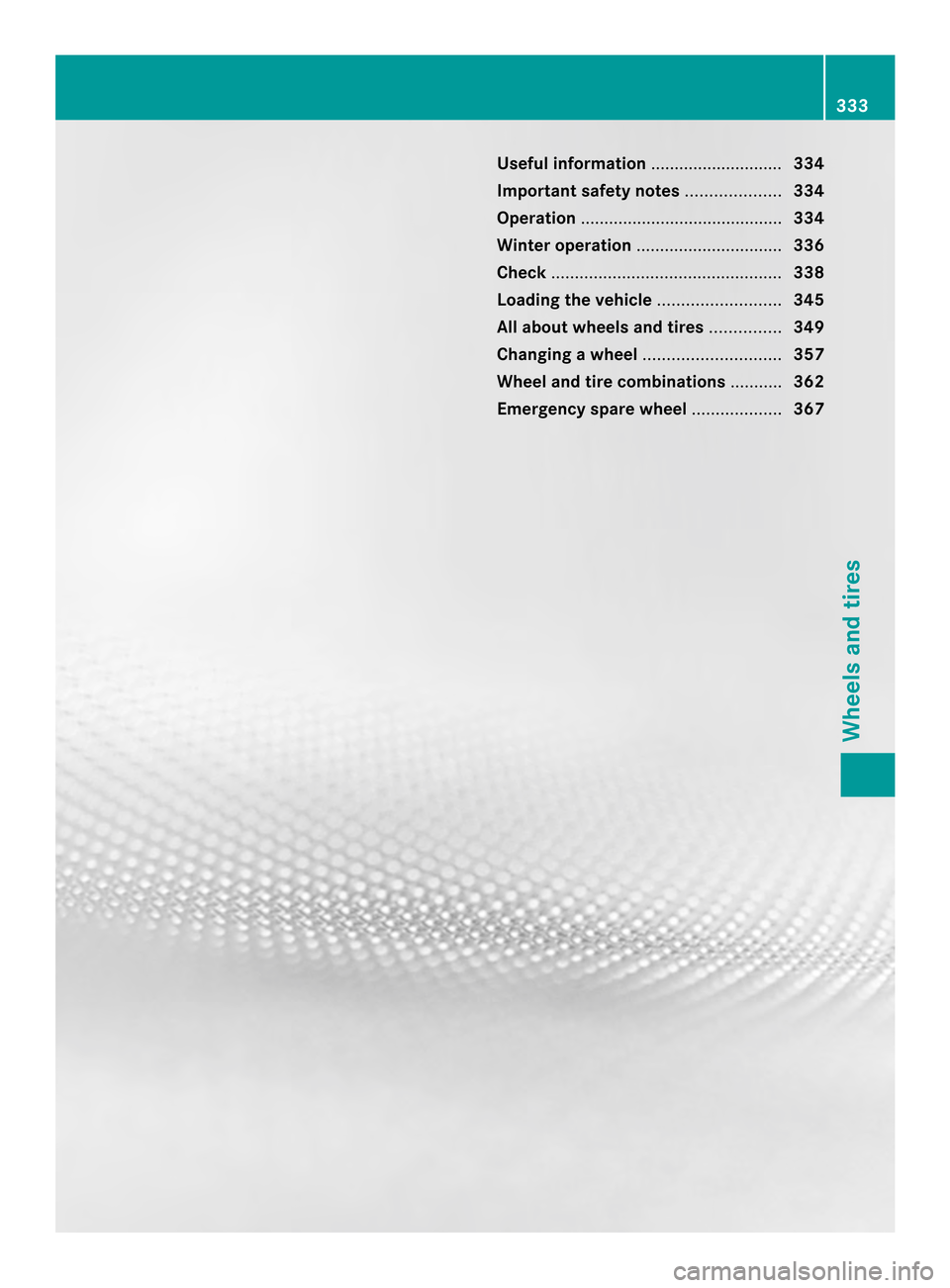
Useful information
............................334
Importan tsafet ynotes .................... 334
Operation ........................................... 334
Winter operation ............................... 336
Check ................................................. 338
Loading the vehicle ..........................345
All about wheels and tires ...............349
Changing awheel ............................. 357
Wheel and tir ecombinations ...........362
Emergency spar ewheel ................... 367 333Wheels and tires
Page 336 of 382
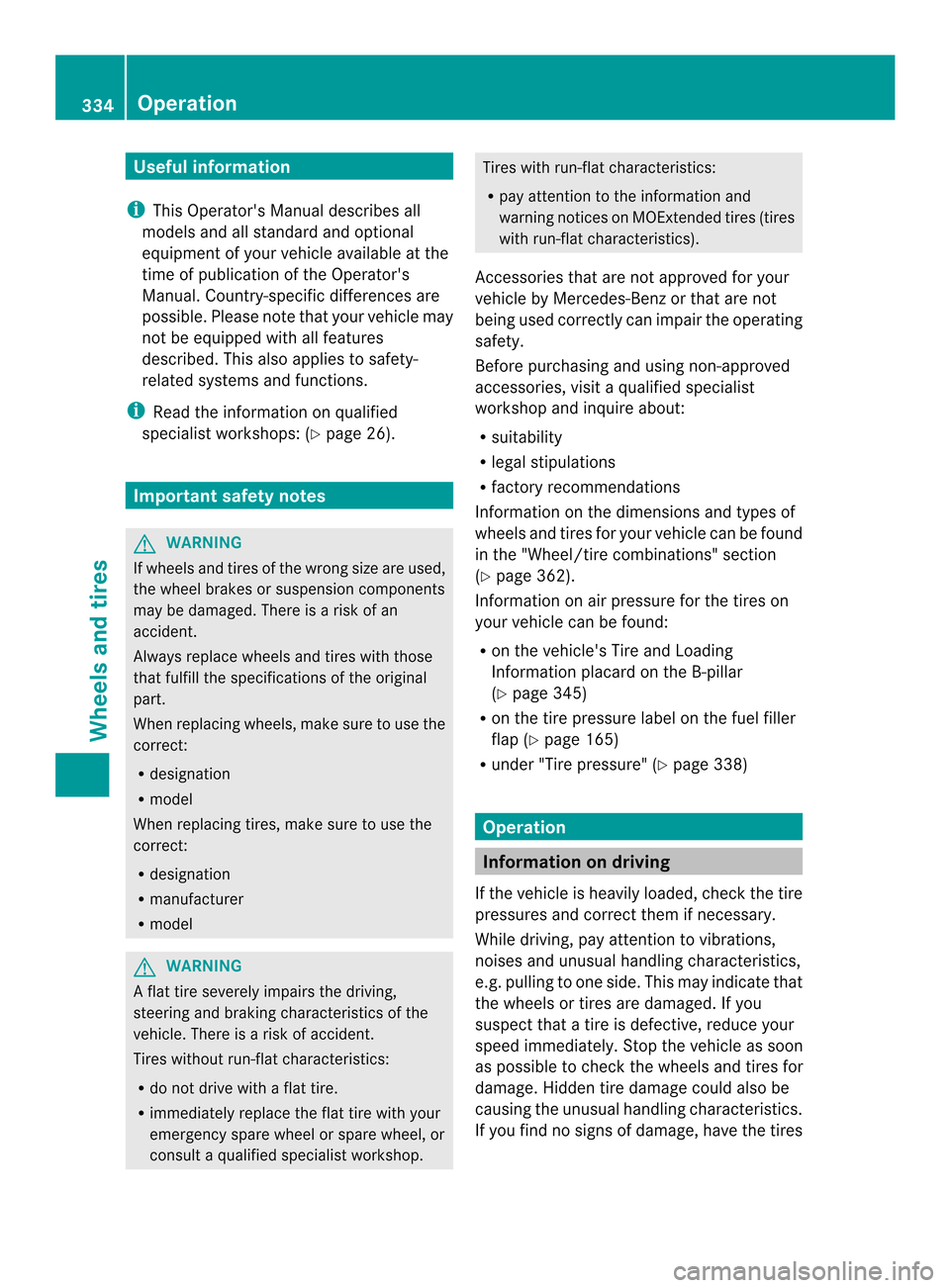
Useful information
i This Operator's Manual describes all
models and all standard and optional
equipment of your vehicle available at the
time of publication of the Operator's
Manual. Country-specific differences are
possible. Please not ethat your vehicle may
not be equipped with all features
described. This also applies to safety-
related system sand functions.
i Read the information on qualified
specialist workshops: (Y page 26).Important safet
ynotes G
WARNING
If wheels and tires of the wrong size are used,
the wheel brakes or suspension components
may be damaged. There is arisk of an
accident.
Always replac ewheels and tires with those
that fulfill the specifications of the original
part.
When replacing wheels, make sure to use the
correct:
R designation
R model
When replacing tires, make sure to use the
correct:
R designation
R manufacturer
R model G
WARNING
Af lat tir eseverely impairs the driving,
steerin gand braking characteristics of the
vehicle. There is arisk of accident.
Tires without run-flat characteristics:
R do not drive with aflat tire.
R immediately replac ethe flat tir ewith your
emergenc yspare wheel or spare wheel, or
consult aqualified specialist workshop. Tires with run-flat characteristics:
R
pay attention to the information and
warnin gnotices on MOExtended tires (tires
with run-flat characteristics).
Accessories that are not approved for your
vehicle by Mercedes-Ben zorthat are not
being used correctly can impair the operating
safety.
Before purchasing and using non-approved
accessories, visit aqualified specialist
workshop and inquire about:
R suitability
R legal stipulations
R factory recommendations
Information on the dimensions and types of
wheels and tires for your vehicle can be found
in the "Wheel/tire combinations" section
(Y page 362).
Information on air pressure for the tires on
your vehicle can be found:
R on the vehicle's Tire and Loading
Information placard on the B-pillar
(Y page 345)
R on the tire pressure label on the fuel filler
flap (Y page 165)
R under "Tire pressure" (Y page 338) Operation
Information on driving
If the vehicle is heavily loaded, check the tire
pressures and correct them if necessary.
While driving, pay attention to vibrations,
noises and unusual handling characteristics,
e.g. pulling to one side. This may indicate that
the wheels or tires are damaged. If you
suspect that atire is defective, reduce your
speed immediately. Stop the vehicle as soon
as possible to check the wheels and tires for
damage. Hidden tire damage could also be
causing the unusual handling characteristics.
If you find no signs of damage, have the tires 334
OperationWheels and tires
Page 337 of 382

and wheels checked at
aqualified specialist
workshop.
When parking your vehicle ,makes ure that
th et ires do no tget deformed by the curb or
other obstacles. If it is necessary to drive over
curbs, speed humps or similar elevations, try
to do so slowly and at an obtuse angle.
Otherwise, the tires, particularly the
sidewalls, may be damaged. Regular checking of wheels and tires
G
WARNING
Damaged tires can cause tire inflation
pressure loss. As aresult, you could lose
control of your vehicle. There is arisk of
accident.
Check the tires regularly for signs of damage
and replace any damaged tires immediately.
Regularly chec kthe wheels and tires of your
vehicle for damage at least once amonth, as
well as after driving off-road or on rough
roads. Damaged wheels can cause aloss of
tire pressure. Pay particular attention to
damage such as:
R cuts in the tires
R punctures
R tears in the tires
R bulges on tires
R deformation or severe corrosion on wheels
Regularly check the tire tread depth and the
condition of the tread across the whole width
of the tire (Y page 335). If necessary, turn
the front wheels to full lock in order to inspect
the inner side of the tire surface.
All wheels must have avalve cap to protect
the valve against dirt and moisture. Do not
mount anything onto the valve other than the
standard valve cap or other valve caps
approved by Mercedes-Ben zfor your vehicle.
Do not use any other valve caps or systems,
e.g. tire pressure monitoring systems. Regularly check the pressure of all the tires
particularly prior to long trips. Adjust the tire
pressure as necessary (Y
page 338).
Observe the notes on the emergenc yspare
wheel (Y page 367).
The service life of tires depends, among other
things, on the following factors:
R Drivin gstyle
R Tire pressure
R Distance covered Important safety notes on the tire
tread
G
WARNING
Insufficient tire tread will reduce tire traction.
The tire is no longer able to dissipate water.
This means that on wet road surfaces, the risk
of hydroplaning increases, in particular where
speed is not adapted to suit the driving
conditions. There is arisk of accident.
If the tire pressure is too high or too low, tires
may exhibit different levels of wear at
different locations on the tire tread. Thus, you
should regularly check the tread depth and
the condition of the tread across the entire
width of all tires.
Minimum tire tread depth for:
R Summer tires: 0015in (3 mm)
R M+S tires: 001Fin (4 mm)
For safety reasons, replace the tires before
the legally prescribed limit for the minimum
tire tread depth is reached. Operation
335Wheels and tires Z
Page 338 of 382
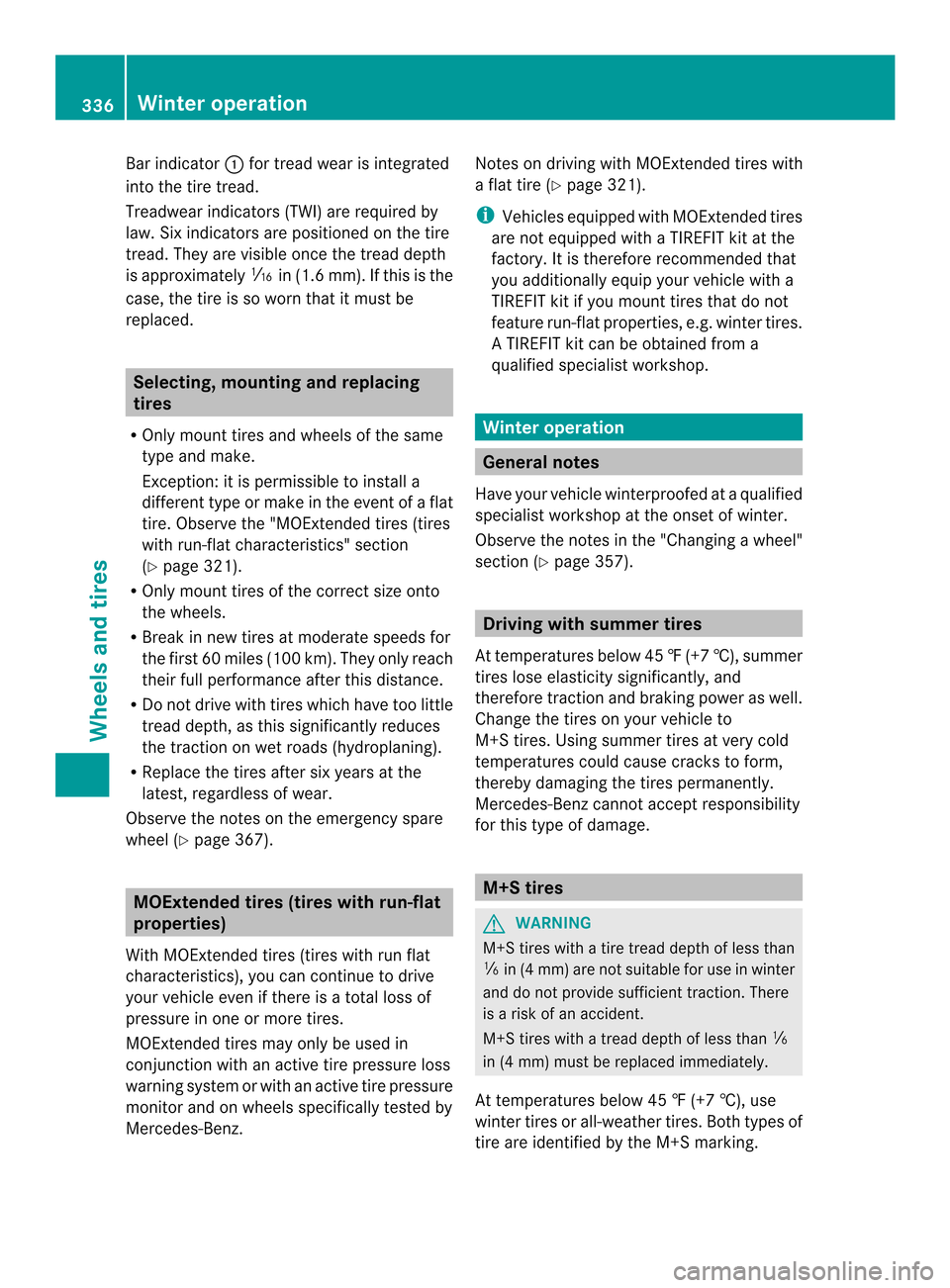
Bar indicator
001Afor trea dwearisi ntegrated
into the tire tread.
Treadwear indicator s(TWI) are required by
law. Six indicator sare positioned on the tire
tread. The yare visible once the trea ddepth
is approximately 0014in (1.6 mm). If this is the
case ,the tire is so worn that it mus tbe
replaced. Selecting, mounting and replacing
tires
R Only mount tires and wheels of the same
type and make.
Exception: it is permissible to install a
different type or make in the event of aflat
tire. Observe the "MOExtended tires (tires
with run-flat characteristics" section
(Y page3 21).
R Only mount tires of the correct size onto
the wheels.
R Break in new tires at moderate speeds for
the first 60 mile s(100 km) .They only reach
their full performance after this distance.
R Do not drive with tires which have too little
tread depth, as this significantly reduces
the traction on wet roads (hydroplaning).
R Replace the tires after six years at the
latest, regardless of wear.
Observe the notes on the emergency spare
wheel (Y page 367). MOExtended tires (tires with run-flat
properties)
With MOExtended tires (tires with run flat
characteristics), you can continue to drive
your vehicle even if there is atotal loss of
pressure in one or more tires.
MOExtended tires may only be used in
conjunction with an active tire pressure loss
warning system or with an active tire pressure
monitor and on wheels specifically tested by
Mercedes-Benz. Notes on driving with MOExtended tires with
af
lat tire (Y page 321).
i Vehicles equipped with MOExtended tires
are not equipped with aTIREFIT kit at the
factory. It is therefore recommended that
you additionall yequip your vehicle with a
TIREFIT kit if you mount tires that do not
feature run-flat properties, e.g. winter tires.
AT IREFIT kit can be obtained from a
qualified specialist workshop. Winter operation
General notes
Have your vehicle winterproofed at aqualified
specialist workshop at the onset of winter.
Observe the notes in the "Changing awheel"
section (Y page 357). Driving with summer tires
At temperatures below 45 ‡(+7 †), summer
tires lose elasticity significantly ,and
therefore traction and braking power as well.
Change the tires on you rvehicle to
M+S tires. Using summer tires at very cold
temperatures could cause crack stoform,
thereby damaging the tires permanently.
Mercedes-Benz cannot accept responsibility
for this type of damage. M+S tires
G
WARNING
M+S tires with atiret read dept hofless than
001F in (4 mm )are no tsuitable for use in winter
and do no tprovide sufficient traction .There
is ar iskofana ccident.
M+S tires wit hatread dept hofless than 001F
in (4 mm )must be replace dimmediately.
At temperatures below 45 ‡(+7 †), use
winter tires or all-weather tires. Both type sof
tir ea re identified by th eM+S marking. 336
Winte
roperationWheels and tires
Page 339 of 382
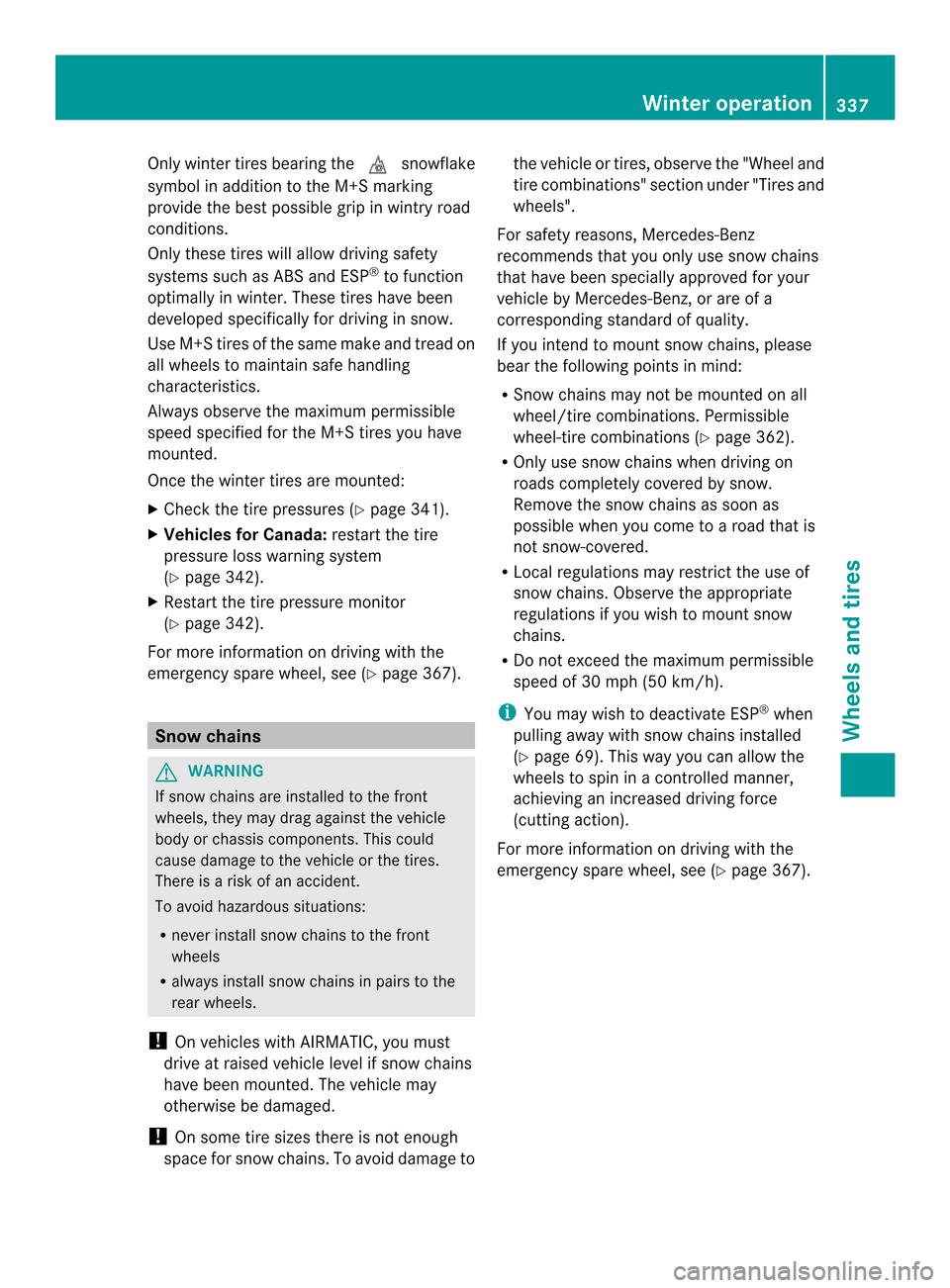
Only winter tires bearing the
0012snowflake
symbol in addition to the M+S marking
provide the best possibleg rip in wintry road
conditions.
Only these tires will allowd riving safety
systems such as ABS and ESP ®
to function
optimally in winter. These tires have been
developeds pecificallyfor driving in snow.
Use M+S tires of the same make and tread on
all wheels to maintain safe handling
characteristics.
Alwayso bserve the maximum permissible
speed specified for the M+S tires you have
mounted.
Once the winter tires are mounted:
X Check the tire pressures (Y page 341).
X Vehiclesf or Canada: restart the tire
pressure loss warning system
(Y page 342).
X Restart the tire pressure monitor
(Y page 342).
For more information on driving with the
emergency spare wheel, see (Y page 367).Snow chains
G
WARNING
If snow chains are installed to the front
wheels, they may drag against the vehicle
body or chassis components. This could
cause damage to the vehicle or the tires.
There is arisk of an accident.
To avoid hazardous situations:
R never install snow chains to the front
wheels
R always install snow chains in pairs to the
rear wheels.
! On vehicles with AIRMATIC, you must
drive at raised vehicle level if snow chains
have been mounted. The vehicle may
otherwise be damaged.
! On some tire sizes there is not enough
space for snow chains. To avoid damage to the vehicle or tires, observe the "Wheel and
tire combinations" section under "Tires and
wheels".
For safety reasons, Mercedes-Benz
recommends that you only use snow chains
that have been speciallya pproved for your
vehicle by Mercedes-Benz,ora re of a
corresponding standard of quality.
If you intend to mount snow chains, please
bear the following points in mind:
R Snow chains may not be mounted on all
wheel/tire combinations. Permissible
wheel-tire combinations (Y page 362).
R Only use snow chains when driving on
roads completely covered by snow.
Remove the snow chains as soon as
possiblew hen you come to aroad that is
not snow-covered.
R Local regulations may restrict the use of
snow chains. Observe the appropriate
regulations if you wish to mount snow
chains.
R Do not exceed the maximum permissible
speed of 30 mph (50 km/h).
i You may wish to deactivate ESP ®
when
pulling away with snow chains installed
(Y page 69). This way you can allow the
wheels to spin in acontrolled manner,
achieving an increased driving force
(cutting action).
For more information on driving with the
emergenc yspare wheel, see (Y page 367). Winter operation
337Wheels and tires Z
Page 340 of 382
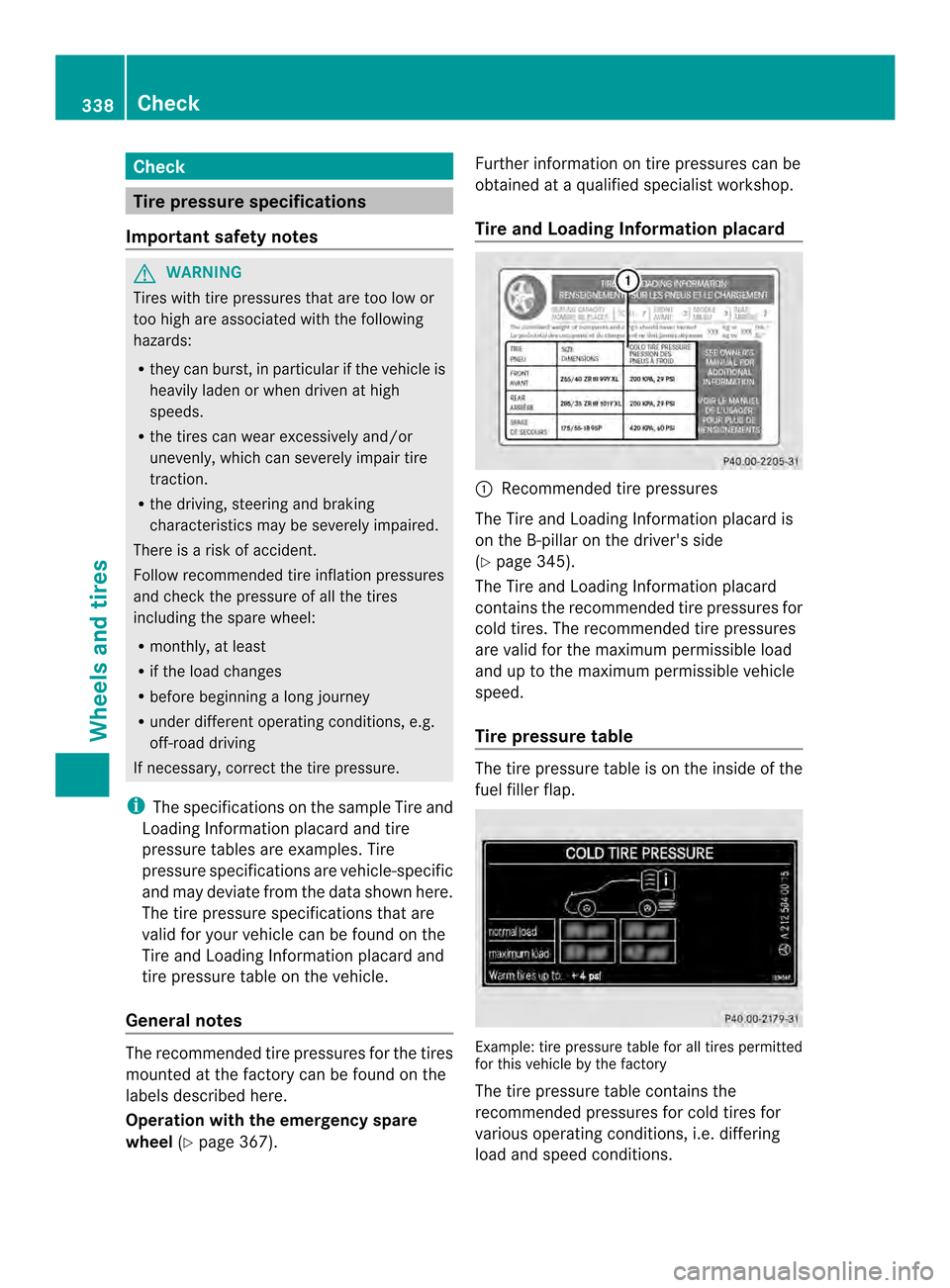
Check
Tir
ep ressure specifications
Important safety notes G
WARNING
Tire switht irep ressure sthata re to olow or
to oh igh are associated wit hthe following
hazards:
R they can burst, in particular if th evehicle is
heavily laden or when driven at high
speeds.
R thet ires can wear excessively and/or
unevenly, whic hcan severely impai rtire
traction.
R the driving, steerin gand braking
characteristics may be severely impaired.
There is arisk of accident.
Follow recommended tir einflation pressures
and chec kthe pressure of all the tires
including the spare wheel:
R monthly, at least
R if the load changes
R before beginning along journey
R under different operating conditions,e .g.
off-road driving
If necessary, correct the tire pressure.
i The specifications on the sample Tire and
Loading Information placard and tire
pressure tables are examples. Tire
pressure specifications are vehicle-specific
and may deviate from the data shown here.
The tire pressure specifications that are
valid for your vehicle can be found on the
Tire and Loading Information placard and
tire pressure table on the vehicle.
General notes The recommended tire pressures for the tires
mounted at the factory can be found on the
labelsd escribed here.
Operation with the emergency spare
wheel (Ypage 367). Further information on tire pressures can be
obtained at aqualified specialist workshop.
Tire and Loading Information placard 001A
Recommended tire pressures
The Tire and Loading Information placard is
on the B-pillar on the driver's side
(Y page 345).
The Tire and Loading Information placard
contains the recommended tire pressures for
cold tires. The recommended tire pressures
are valid for the maximum permissible load
and up to the maximum permissible vehicle
speed.
Tire pressuret able The tire pressure table is on the inside of the
fuel filler flap.
Example: tire pressure table for all tires permitted
for this vehicle by the factory
The tire pressure table contains the
recommended pressures for cold tires for
various operating conditions, i.e. differing
load and speed conditions.338
CheckWheels and tires